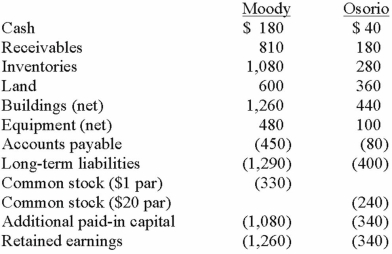On January 1, 2013, the Moody Company entered into a transaction for 100% of the outstanding common stock of Osorio Company. To acquire these shares, Moody issued $400 in long-term liabilities and 40 shares of common stock having a par value of $1 per share but a fair value of $10 per share. Moody paid $20 to lawyers, accountants, and brokers for assistance in bringing about this acquisition. Another $15 was paid in connection with stock issuance costs. Prior to these transactions, the balance sheets for the two companies were as follows:  Note: Parentheses indicate a credit balance.
Note: Parentheses indicate a credit balance.
In Moody's appraisal of Osorio, three assets were deemed to be undervalued on the subsidiary's books: Inventory by $10, Land by $40, and Buildings by $60.
What amount was recorded as the investment in Osorio?
Definitions:
Dividend
A share of a firm's income allocated to its stockholders, often in cash or extra shares.
Perceivable Future
A concept referring to events or conditions that can reasonably be foreseen or predicted.
Quarterly Dividend
A payment made by a corporation to its shareholders, usually as a distribution of profits, every three months.
Par Value
The face value of a bond or stock as stated by the issuer, which bears significance for accounting and financial regulation.
Q3: DNA is isolated from a test organism
Q6: Jaynes Inc. acquired all of Aaron Co.'s
Q13: Which of the following is the most
Q16: The following methods that are used to
Q26: Which of the following is the correct
Q82: During 2012, Von Co. sold inventory to
Q92: Following are selected accounts for Green Corporation
Q98: Which of the following statements is false
Q109: Bauerly Co. owned 70% of the voting
Q114: Kaye Company acquired 100% of Fiore Company